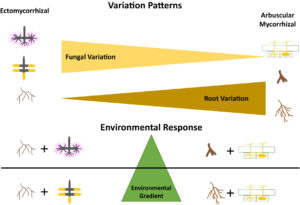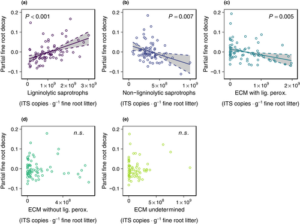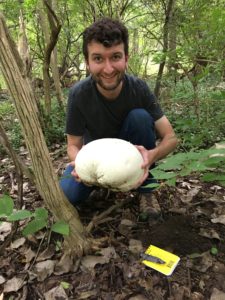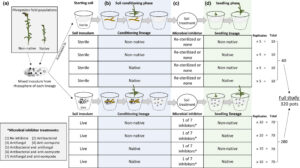
Zak lab paper out!
Brooke Propson, a PhD student at the University of Wisconsin, whom works in Zac Freedman’s lab (former Zak lab post-doc), studied the ecosystem response and recovery after the long-term elevated nitrogen treatment was stopped. There is also a natural gradient of ambient N deposition due to human activity at these sites, as well. The study showed that the C in the organic horizon that has previously accumulated from N-treatment has been lost with added deficits post-termination of the treatment with the exception of the northernmost site (least ambient N), showing a shift in mechanistic microbial activity. The mineral soil C still remained observable even after the 5-year termination of the treatment (though not significant). They concluded that most likely the sites are in a disturbed state and will most likely still exhibit higher levels of C storage overtime. The paper is out now and can be found here ...

Zak lab paper out!
Sam Schaffer-Morrison, former SEAS student and current PhD in EEB at Michigan, has a review out with Don that argues that functional traits of mycorrhizal fungi should be included for consideration when belowground functional traits are being examined. These are incredibly important symbionts could add key mechanistic factors for plant performance (via nutrient uptake) if included in plant-soil discussions. They propose several key fungal traits that are measurable and ways to incorporate them into future research. This paper is out in Ecosphere here ...

Forest Ecology Out!
A revised 5th edition of Forest Ecology (ISBN 1119476089) is out now! Don is one of the co-authors. It has been 25 years since the previous edition and the authors wanted to retain the overall focus from the previous edition (ecosystem level), but update the text to include information about new ecological concepts and methods, and critical areas interest like sustainability. Don took a lot of care (and an enormous investment in time) to update the text, images and references for all the chapters that he worked on. It’s out now and you can get it most book sellers (and there is a PDF version). Congrats Don for a job well done! ...

Will’s paper is out
Will Argiroff, former PhD student in SEAS, has a new paper out titled “Fungal community composition and genetic potential regulate fine root decay in northern temperate forests” that examined if fine root litter (~50% total litter production in forest ecosystems and fairly recalcitrant) decayed more rapidly when fungal communities have more genes that are known to degrade litter. The study also looked into if you could classify fungi by saprotrophic or ectomycorrhizal functional groups by the genes present. Fine roots were placed in forest sites and the fungal communities were sequenced, which where then compared to available fungal genomes to examine decay genes. Fine root decay occurred more rapidly where fungi had more decay genes and was correlated with saprotrophs that degrade lignin (negatively so with ECM). The paper is out in Molecular Ecology can be found here ...
Welcome Morgan!
Morgan McPherson is jointly joining the Zak lab and Ibanez lab (SEAS) for an NSF-funded post-doc to study arbuscular mycorrhizae in our sites in the Manistee National Forest. She comes to us from the University of Nebraska-Lincoln, where she studied AMF in agroecosystems. Welcome Morgan!! ...

Congrats Will!
Congratulations to Will Argiroff for completing his dissertation in SEAS! Will has been in and around the lab for many years, starting as an undergrad working with one of our postdocs (Zac Freedman), then as research technician doing crazy amounts of qPCR and finally as a PhD student. Will’s work for his PhD research broadly looked at linking microbial communities to decomposition and nutrient cycling in forest ecosystems, but specifically he studied some of the more recalcitrant forms of carbon (lignin and soil organic matter) and the microbes involved in degrading them to make them accessible for other organisms, which have long term consequences for how carbon is stored in these systems as well how nitrogen affects can aid or slow this process. He looked at communities that decay fine roots in both experimentally elevated nitrogen-addition sites, as well as natural forest systems that have a mineralization gradient. He also studied how certain mycorrhizae (ECM) contribute to decay over a span of nitrogen availability. Spoilers – increased nitrogen in the environment slowed root (and lignin) decay leading to SOM accumulation furthermore ECM that can decay SOM effectively declined with increasing N availability, also contributing to slower decay of SOM/lignin. His dissertation is titled “Fungal Community Composition Regulates Fine Root Decay: Implications for the Cycling and Storage of Carbon in Terrestrial Ecosystems”. He will be starting his post-doc at Oak Ridge National Lab in July. Thanks so much Will for all the great memories and all the amazing work! ...

Yay Jennifer!
Congratulations to Jennifer Wen for successfully completing her thesis to earn her MS from SEAS! Jennifer started in the lab fall 2020 and managed to complete her thesis despite all the hurdles from pandemic restrictions and supply issues alongside all the usual unexpected issues for environmental research. I feel like there should be a special seal for her diploma. Jennifer’s work looked at a specific gene involved in nitrification, amoA, that is the key process for nitrogen cycling where ammonia is eventually converted to nitrate for uptake by other organisms. This process is only done by specific ammonia-oxidizing microbes, so insight into this gene gives information about those specific microbial communities. Her thesis focused on the archaeal groups (AOA) that have this gene. Using molecular methods and sequencing, Jennifer examined the abundance and diversity of amoA in soil from Manistee National Forest. These sites were of similar age and plant communities but across a natural gradient of inorganic nitrogen amounts in the stands. The amoA communities formed distinct groupings by site, and she tested various environmental variables and found that soil pH and nitrogen mineralization were significantly different across the stands. Her results build and improve on our understanding of the nutrient cycling from a microbial ecology perspective in these forest ecosystems. Her thesis presentation, part of the SEAS Capstone Symposium, was titled “Does Mineralization and pH Control the Distribution of Ammonia-Oxidizing Archaea in Temperate Forest Soils?” and can be found here (link in future) ...

Wes Bickford’s paper is out!
A former member of the Zak lab has recently published a paper, titled “Plant effects on and response to soil microbes in native and non-native Phragmites australis” in Ecology. The aim of the study was to examine if Plant–soil feedbacks (PSFs) mediate plant community dynamics with specific focus on if this could contribute to plant invasions. He did a series of microbial inhibitor treatments on native and non-native Phragmites, but found that opposite of expectations both lineages were negatively impacted, especially the non-native plants, which indicates that that the success of non-native Phragmites is not a result of soil microbe – plant interactions. It can be found here ...